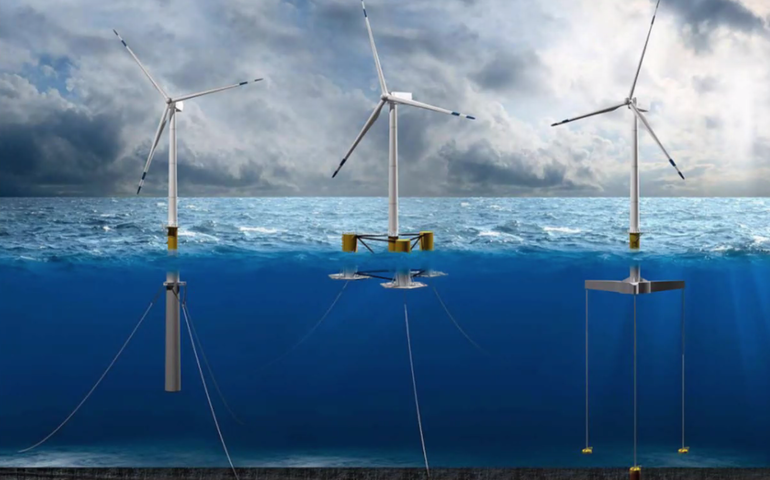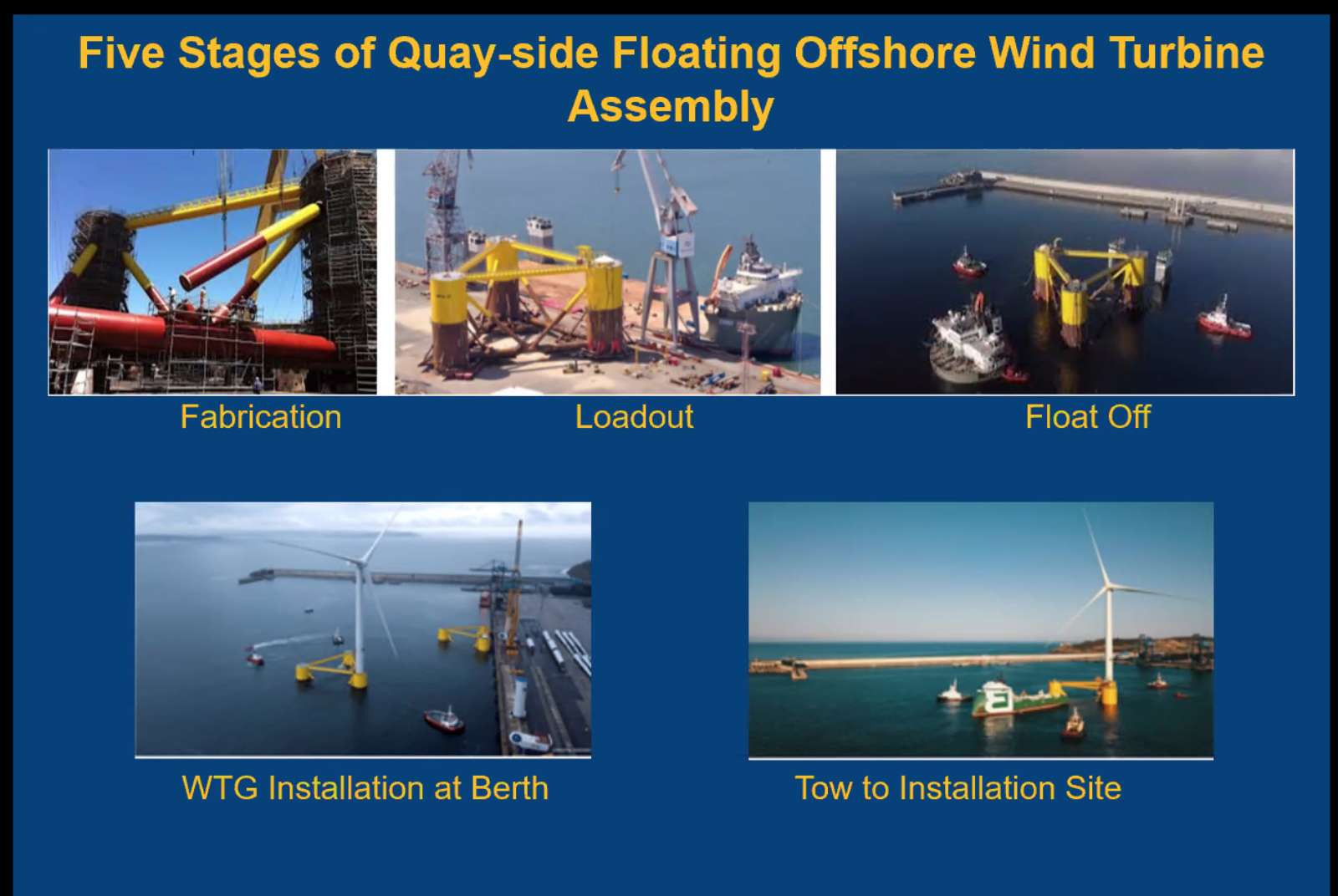
State eyes concepts for developing Searsport as offshore wind hub
 Screenshot / Courtesy, Maine Department of Transportation
From left in this illustration, a spar foundation, semi-submersible and a tension platform are examples of floating wind turbine foundations. Maine is looking at semi-submersible foundations.
Screenshot / Courtesy, Maine Department of Transportation
From left in this illustration, a spar foundation, semi-submersible and a tension platform are examples of floating wind turbine foundations. Maine is looking at semi-submersible foundations.
State agencies have developed concepts to use the port of Searsport as a manufacturing hub for the burgeoning offshore wind industry.
“We envision an entire port concept,” said Matthew Burns, director of ports and marine transportation with the Maine Department of Transportation.
Burns spoke during a webinar last week, hosted by Augusta public policy nonprofit Maine Conservation Voters, on proposed plans to develop the port for offshore wind.
In November, Gov. Janet Mills directed her administration to study options for renewable energy development at the state's commercial ports, calling offshore wind an "unprecedented economic and investment opportunity for Maine.”
Led by the Governor's Energy Office, the Maine Department of Transportation and other agencies, officials are looking at a variety of wind options at Searsport, Portland, Eastport and others.

The studies are expected to guide development of Maine’s Offshore Wind Roadmap, a strategic planning process coordinated by the Governor’s Energy Office.
Searsport feasibility
In March 2020, Mills requested that MaineDOT conduct a feasibility assessment at the port of Searsport to explore the marine infrastructure requirements necessary to construct floating offshore wind turbines.
MaineDOT selected New York City engineering consultant Moffatt & Nichol to evaluate the feasibility of using the existing Mack Point Terminal at Searsport to service the offshore wind industry.
The evaluation considered multiple terminal sites for either wind turbine generator marshalling or fabrication, for both fixed and floating foundation offshore wind turbines, according to the consultant’s website.
Moffatt & Nichol prepared infrastructure assessments that included conceptual layouts, preliminary concept designs, construction schedules and opinions of probable cost.
With the public release of the Moffatt & Nichol Searsport study last November, MaineDOT and the state are continuing work to explore the possibilities of bringing the industry to Maine while engaging in a stakeholder outreach effort.
Meanwhile, the state has also begun pursuing a lease area to develop a floating offshore wind turbine research array as well as a collaborative roadmap planning effort.
Manufacturing facilities
Burns said the feasibility study for Searsport was designed to identify sites for facilities to manufacture floating foundations and turbine generators, at both research and commercial scales.
Criteria for potential sites include:
- 1,300 to 1,600 feet of berthing area for two vessel berths plus an assembly area for turbine foundations. About 33 to 35 feet of draft at the berth would be needed, along with a 50- to 60-foot-deep sinking basin.
- About 40 to 80 acres of level upland area would be needed, along with a robust quay loading area that could withstand pressures of 5,000 pounds per square feet, in order to be able to move and stage massive components.
Additional requirements include a semi-submersible barge, rail or other type of launching system — a way to get the foundations and turbines from land into the ocean. Once the turbine is installed on the foundation, the assembly will need clear passage to its installation site, precluding height restrictions from structures such as bridges.

The fabrication and launch of the foundations involve a number of steps, he said.
The foundations usually are concrete, steel or a combination, so significant casting or steel fabrication processes would be involved.
The foundations would need to be loaded onto a rolling asset, like a barge or heavy lift vessel. A series of self-propelled modular transporters would roll each foundation onto the rolling asset.
Once the foundation is loaded, the rolling asset would be designed to submerge itself in order to allow the foundation to become buoyant and then float away from the asset.
The foundation would then be brought back to the berth for installation of the wind turbine generator. Then the assembly would be towed to the installation site, using a large tug-like vessel.
Four potential sites
An active seaport since the 1700s, Searsport is Maine’s second largest deep-water port.
The study evaluated four sites there: Mack Point Terminal, which already handles bulk shipments and has potential for further development, an undeveloped parcel of land north of the nearby Sprague Energy terminal, about 100 acres available at an industrial park owned by GAC Chemical Corp., and a parcel of land owned by Maine DOT on the west side of Sears Island.
Some of the sites would be suitable for fabricating and launching turbines, Burns said.
The concept is to utilize available acreage in the port to build efficiency and create a versatile port system “that’s unlike anything else on the East Coast currently,” he said.
So far, the concept incorporates some of the Mack Point parcel, a small portion of the Sears Island parcel and potentially the GAC industrial park site, he said.
Planning is in the concept phase and not based on any contractual arrangement for property, he stressed.
“It’s a conceptual exercise to see what we have the capability to do,” he said. “All three sites might support the goal of commercial fabrication.”
Development costs, depending on locations and size of the project, would range from $100 million to nearly $300 million. Certain areas would require underwater blasting and dredging to remove ledge and deepen basins.
Bigger picture
The state’s bigger-picture view envisions Portland and Eastport also playing a role in offshore wind development, Burns said.
For instance, Searsport is viewed as a manufacturing hub, Portland is a prime candidate for an operations and maintenance facility and Eastport, with the deepest water on the East Coast, could play a role in providing facilities where wind turbine components could be manufactured.
This year, the goal is to move beyond concepts and consider practicable alternative designs, environmental analysis, costs and funding options for Searsport, said Burns.
To that end, he said, the state will continue to work with stakeholders to collect more data about the proposed sites. The state will likely develop a website to be a clearinghouse for information about the Searsport project going forward, he said.
Renewable energy goals
Celina Cunningham, deputy director of the Governor's Energy Office, said the state is pursuing offshore wind for a number of reasons. From a climate change perspective, she said, the state is looking to meet targets that include nearly doubling the amount of electricity available in the next 20 to 30 years, which will require significant new clean energy sources to allow for electrification.
Meeting the goal involves developing a diverse mix of energy sources, using both onshore and offshore resources, she said.
The state also sees opportunity for economic growth potential and adding jobs.
Given the deep-water depths in the Gulf of Maine, the state is pursuing floating technology rather than fixed bottom platforms, she said.
Offshore development requires substantial shoreside infrastructure, she said.
“Along the East Coast, states are taking steps to support port infrastructure for anticipated project development we’ll be seeing,” Cunningham said.
The state is working with the federal government to understand leasing strategy and to coordinate with agencies like the National Oceanic and Atmospheric Administration to obtain information on potential impacts of offshore wind on other ocean users such as the fisheries and on the marine environment.
In July 2021, Maine launched a Maine offshore wind roadmap process to analyze, with stakeholders, near-term and long-term recommendations to support the growth of the offshore wind industry in Maine. Over 100 experts have been meeting regularly since then at meetings open to the public, she said.
Friends of Sears Island weighs in
In its latest annual report, issued in January, Friends of Sears Island objected to using the western side of Sears Island for the manufacturing operation.
“The environmental impacts to the island from the proposed port development would be significant: about 105 acres of woods would be cleared and upland area graded, the hillside would be cut into to remove over a million cubic yards of soil to be used to build a staging area and quay extending almost 1,000 feet out into the bay; and over 17 acres of intertidal and subtidal marine wetlands would be filled in,” the group said.
Other effects on the island, the group said, would include traffic and disruption from trucks delivering construction materials; an 800-foot crane, needed to assemble the wind turbines, visible from anywhere on the island; reduced access to the western shore and inability for visitors to circumnavigate the island; significant noise disturbance from the manufacturing facility, and light pollution resulting from the site being lit up 24 hours a day to maintain security.
“In short, people would no longer be able to enjoy a serene and restorative visit to the island,” the group said.
The group said it supports the development of renewable energy sources “but believes it would be more appropriate to build the wind turbine facility on an already disturbed industrial site, such as Mack Point in Searsport, rather than irreparably damage an ecologically intact island.”










0 Comments